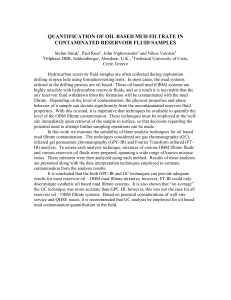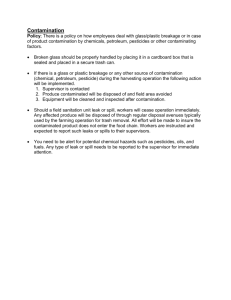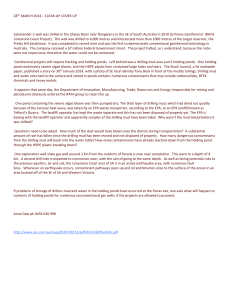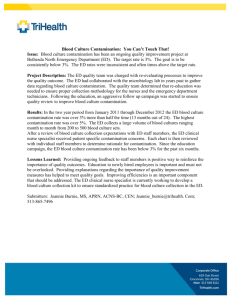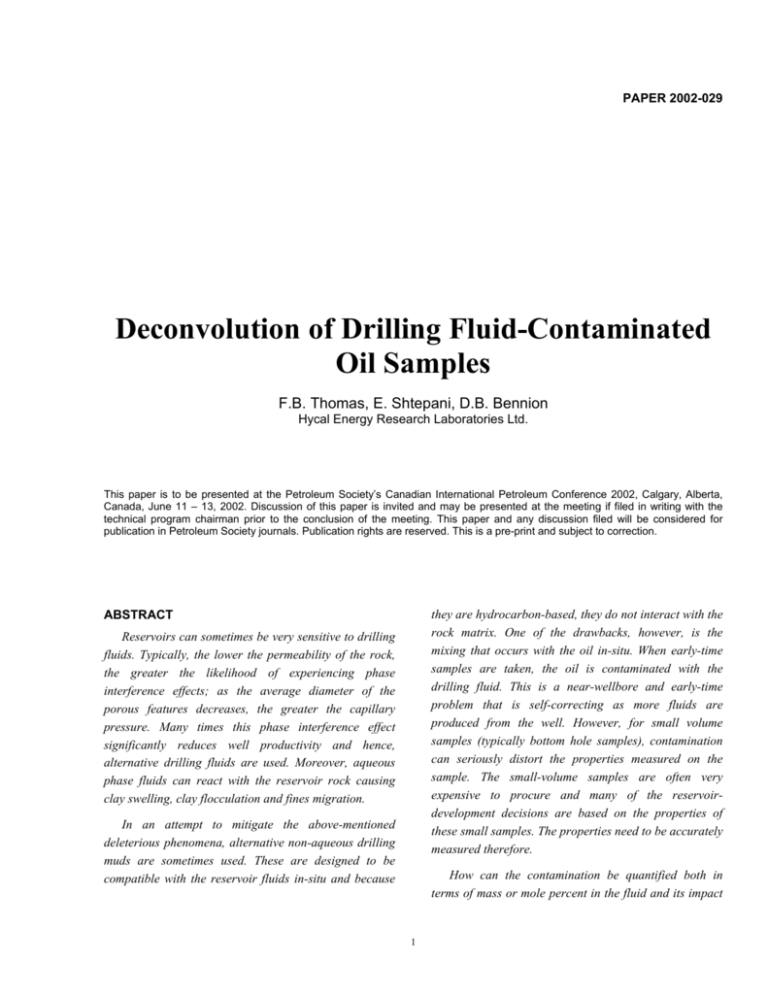
PAPER 2002-029
Deconvolution of Drilling Fluid-Contaminated
Oil Samples
F.B. Thomas, E. Shtepani, D.B. Bennion
Hycal Energy Research Laboratories Ltd.
This paper is to be presented at the Petroleum Society’s Canadian International Petroleum Conference 2002, Calgary, Alberta,
Canada, June 11 – 13, 2002. Discussion of this paper is invited and may be presented at the meeting if filed in writing with the
technical program chairman prior to the conclusion of the meeting. This paper and any discussion filed will be considered for
publication in Petroleum Society journals. Publication rights are reserved. This is a pre-print and subject to correction.
ABSTRACT
they are hydrocarbon-based, they do not interact with the
rock matrix. One of the drawbacks, however, is the
mixing that occurs with the oil in-situ. When early-time
samples are taken, the oil is contaminated with the
drilling fluid. This is a near-wellbore and early-time
problem that is self-correcting as more fluids are
produced from the well. However, for small volume
samples (typically bottom hole samples), contamination
can seriously distort the properties measured on the
sample. The small-volume samples are often very
expensive to procure and many of the reservoirdevelopment decisions are based on the properties of
these small samples. The properties need to be accurately
measured therefore.
Reservoirs can sometimes be very sensitive to drilling
fluids. Typically, the lower the permeability of the rock,
the greater the likelihood of experiencing phase
interference effects; as the average diameter of the
porous features decreases, the greater the capillary
pressure. Many times this phase interference effect
significantly reduces well productivity and hence,
alternative drilling fluids are used. Moreover, aqueous
phase fluids can react with the reservoir rock causing
clay swelling, clay flocculation and fines migration.
In an attempt to mitigate the above-mentioned
deleterious phenomena, alternative non-aqueous drilling
muds are sometimes used. These are designed to be
compatible with the reservoir fluids in-situ and because
How can the contamination be quantified both in
terms of mass or mole percent in the fluid and its impact
1
on the sample properties? This paper describes two
technologies developed to achieve this. The first is
applicable to synthetic hydrocarbon drilling fluids where
the concentration of components is restricted to very few
components. The second technique applies to those fluids
that contain a more broad distribution of hydrocarbon
components.
is therefore to determine what fraction of the sample
(some amount of reservoir fluid plus some amount of
drilling fluid – both of which are unknown) is
contaminated. Once the degree of contaminant is
quantified, EOS techniques can be employed to “back
out” the effect on the properties. How these steps are
accomplished will be described next.
The results indicate that the resolution of
contamination can be achieved to within 1 mass percent
accuracy. Using the degree of contamination with
Equation of State methods, can they predict properties of
the reservoir fluid to within 4% of actual value?
For the determination of contamination fraction,
Figure 2 describes the common distribution observed for
most reservoir fluids. By plotting the log number of
moles versus carbon number, a good straight line relation
is obtained. Extrapolating to infinite numbers provides
the number of moles in the reservoir fluid. Comparing
Figures 1 and 2, even if the only sample of reservoir fluid
is contaminated, one can measure the number of moles of
contaminant by chromatography.
OBJECTIVE
The objective of this work is to develop a technique
that will quantify how much contamination is present in
the sampled oil and then provide a means by which PVT
parameters on reservoir fluid can be approximated from a
contaminated sample. The basis for this work is having
no “clean” oil available and therefore the uncontaminated
properties must be extrapolated from the available
samples. The scope of the work consists of:
•
Mathematical development
•
Additional experimental data on selected samples
•
Validation of mathematical approach
•
Estimation of the oil-based
contamination on selected samples
Once the moles of sample are known, the following
equations can be used to determine uncontaminated
properties:
Molecular Weight
MW sample = Mole Fractionoil MWoil + (1 − MFoil ) MWconta min ant (1)
where MFOil – Mole Fraction Oil
Density
ρsample = VFoilρoil + (1 − VFoil )ρconta min ant
mud
filtrate
(2)
where VFoil – Mass Fractioni ρtotal/ρi according to ideal
mixing.
METHODOLOGY
Once the mole fraction, MW and density of the oil are
determined then all the parameters are known for EOS
modeling. So to review, by superposition:
Depending on the type of drilling fluid, the
determination of the amount of contamination can be
facile or it may be somewhat more involved. From the
authors’ experience, drilling fluids whose compositional
distribution is very narrow are the easiest to correct. This
type will be discussed in the first section. Those drilling
fluids that possess a much broader distribution of
components are more difficult to quantify. This type is
discussed in Section 2.
1. Moles of oil and contaminant are determined.
2. Mass and volume fractions are calculated.
3. With these, the mole fractions of oil and contaminant,
density of uncontaminated oil and the molecular
weight of the uncontaminated oil are calculated.
4. The C6+ characterization can then be done for the plus
fraction of the oil. The contaminant can be
characterized separately.
Type 1 – Narrow Range of Components
The procedure for correcting for contamination is
therefore:
Figure 1 depicts what is intended by a narrow range of
components in the contaminating drilling fluid. There is
an obvious peak associated with C10 to C15. The first step
2
1. Two sets of hypothetical components are used: one
for the oil C6+ and one for the contaminant
components.
field. X imud is the mass fraction of component
2. Base grouped properties are based on oil properties.
and are the mass fraction of the drilling fluid, or mud, in
3. Plus fraction properties are modified to match
experiment data.
the oil sampled and X oil
i is the amount of the component
mud (also known). However, A and
are unknown
Mud
Mud + Oil
2. The EOS is tuned to the experimental data with the
two sets of hypothetical components.
and this is the objective of the development.
3. Theoretically the contaminant is removed and the
“uncontaminated” oil properties are provided.
Using Equation (3), two unknowns and one equation, we
have a non-unique solution and, in fact, many solutions.
Another equation was therefore sought.
Using this protocol, Figures 3 and 4 show the
predictions of bubble point pressure and the error as a
function of contamination level. Figures 5 to 7 provide
the same comparison between predicted and experimental
for Bo, GOR and density. The EOS predictions, in all
cases, were based on an EOS tuned to the contaminated
PVT data, measured experimentally, and then the
contamination was “removed” in the EOS model. The
experimental values, in the figures, were those measured
on an uncontaminated sample.
A physical procedure was used to “spike” the sample
with a known quantity of drilling fluid, or mud. The same
relationship can be used with the spiked sample, as
Equation (3)
Z spike
= BX imud + (1 − B) X oil
i
i
(4)
Mud + Spike Mass
Mud + Oil + Spike Mass
B is now
Type 2 – Broad Range of Components
A and B can therefore be expressed as
Many times, a less refined hydrocarbon stream is used
as the drilling fluid. In such cases, the determination of
the degree of contamination is more challenging. Figure 8
shows four profiles: the reservoir fluid, as sampled,
possibly containing some contaminants, the same sample
spiked with 10 mass % and 50 mass%. There is a trend as
contamination increases, but the difference is much more
subtle than with a fluid where the component range is
narrow. What follows is the development of a technique
to remove the amount of contaminant.
A = α 1 Mud + β1
B = α 2 Mud + β2
To test the applicability of this approach, two samples
were prepared: one with approximately 10% mud
addition and another with approximately 50% mud
added.
The actual numbers were:
1.
0.7739 g of sampled oil
0.0867 g of mud
2.
0.6480 g of sampled oil
0.6688 of mud
MATHEMATICAL DEVELOPMENT
At first the problem seems trivial. A simple statement
of mass balance is
Zi
in the
A can be generally defined as
1. Measurements are made on the contaminated sample.
where
i
in the “clean” oil, which is unknown.
With this procedure, the effects of contamination can
then be removed by:
Z i = AX imud + (1 − A ) X oil
i
X oil
i
(3)
Therefore,
A = α 1 Mud + β1 =
is the composition (mass fraction) of
component i, in the sampled oil, as received from the
α 1 = 116198
.
3
Mud + 0.0867
0.7739 + 0.0867
β1 = 010074
.
of these same mass fraction functions. Figure 9 provides
the Y intercept and the slope of these data as a function of
mud filtrate mass fraction. The assumed mud filtrate
fraction determines the location of the three points along
the x-axis (the 100% filtrate fraction does not change in
location). Extrapolation back to zero provides a best fit
log linear approximation of uncontaminated oil. The X
axis is defined as:
For the second addition:
.6480
Mud
+.6688
.7739
B = α 2 Mud + β2 =
.6480+.6688
α 2 = 0.63587
β2 = 0.50789
The 0.648/0.7739 factor is used so that A and B can be
related through one variable, mud.
X=
Equation (4) can then be assembled for every component
Mud + SpikedMud
Mud + Oil + SpikedMud
(5)
i
(
)
(
)
Due to the non-linear nature of the equations, the
algorithm is as follows:
(
)
(
)
1. Assume mud filtrate fraction (MF).
ZSi 1 = α 1 Mud + β1 X iMud + 1 − α 1 Mud − β1 X Oil
i
ZSi 2 = α 2 Mud + β2 X iMud + 1 − α 2 Mud − β2 X Oil
i
2. Compute mass of MF in oil.
Put into matrix form, we have
(
α X Mud − X Oil
i
1 i
β2 X iMud − X Oil
i
(
)
)
3. Calculate X corresponding to the two spiked samples
(Equation 3).
(1 − β1 ) Mud ZSi 1 − β1X iMud
=
Oil S2
Mud
(1 − β2 ) X i Zi − β2 Xi
4. Regress on the values of Y intercept and slope of
Figure 8.
5. Calculate mass fraction of component i in
uncontaminated oil based on extrapolated intercept
and slope at the zero contamination condition*.
Analyzing the integrity of the equations by computing the
rank of the coefficient matrix:
(
α 1 X iMud
−
X Oil
i
)(1 − β2 ) − (
α 2 X iMud
−
X Oil
i
6. Use Equation 4 to compute Xioil for each component
equation based on MF assumed initially.
)(1 − β1 )
or
7. Iterate on MF until a minimum error between step 5
and step 6 summed over components 13-29 is
achieved.
α 1 (1 − β2 ) − α 2 (1 − β1 )
Substituting the values for α 1 , α 2 and β1 , β2 :
* This is part of the iteration. This should not be
construed to be the final answer but is part of the
iteration process, wherein an update of the oil
composition is achieved.
116198
.
(1−.50789) − 0.63587 (1−.10074) = 0
Consequently, the determinant is zero and therefore the
equations are not independent. There would be infinite
solutions or at least multiple solutions. Another
independent relation is required. Another approach was
therefore investigated.
The objective function versus contamination level for
the sample is shown in Figure 10. This analysis indicated
that the sample, as received, had 4.8 mass % mud filtrate
contamination.
Objective Function Minimization Approach
Validation of Mathematical Approach
Studying the mass fraction versus carbon number
relationship, there is a very good log linear functionality.
Figure 8 shows this for the subject sample. Of increased
importance is the correlation of the slope and Y intercept
Since this approach is numerical and relies upon
minimization of a residual sum of squares, two test cases
were performed so that the algorithm could be ratified.
The results ensue.
4
A “blind” test was performed by choosing a separate
cylinder to which a specific quantity of mud filtrate was
added. This “contaminated” sample was then used as the
base oil. Two “spikes” were then performed by adding
specific masses of mud filtrate to known masses of the
base oil (oil plus the unknown quantity of mud filtrate).
The objective was to use the above-described approach
and to compute the amount of the mud filtrate used to
contaminate the oil from the second cylinder.
actual composition based upon the protocol defined in
this report.
The algorithm was used and the objective function
from step 7 (from the above algorithm) was minimized.
Figure 11 shows the result. The mass of mud filtrate that
was added to the oil was 0.6802 grams and the oil mass
was 2.6438 grams, or a mass fraction contamination of
0.2046. From the above algorithm a value of 0.21 was
computed. The error was approximately 0.50 mass %.
Figure 12 shows the y intercept and the slope relationship
as a function of contaminated fraction. They are very
linear and therefore the extrapolation to the zero
contamination condition should be trustworthy. The
result in Figure 11 confirms this even at 20.5 mass %
contamination. Table 1 shows the compositions of the
corrected oil and the actual oil. Working from the 20%
contaminated base line, the corrected oil compares
closely with the actual. Figure 13 shows the same data
along with the errors involved. (In light of the intrinsic
errors of the chromatograph for values less than 1 mass
%, the absolute errors are reported, instead of percentage
errors, for those specific components.)
the reservoir fluid as received. For the viscosity study, the
EOS Calculated PVT Properties of Corrected
Fluid
The PVT properties of the corrected reservoir fluid
were calculated using the modified Peng-Robinson
Equation of State1 and tuning the parameters to match the
measured data obtained from differential liberation with
Pedersen’s Corresponding Method correlation (1984)2
was used. The PVT properties of uncontaminated and
contaminated samples are shown in Tables 3 through 5
and in Figures 17 through 20.
All calculations were performed using the cubic EOS
based Software WinPROP, CMG Modelling Group Ltd.
The trends with deconvolving the contaminated
samples were, in going from contaminated sample (4.89)
to clean oil:
Another blind contamination test was then performed.
This time, a separate cylinder (#3) was contaminated with
mud filtrate: 3.7917 grams of oil and 0.4401 grams of
mud filtrate (filtrate mass fraction contamination of
0.1040). The above algorithm was used again and the
result is shown in Figure 14. A value of 9.6 mass %
contamination was computed compared to the value of
10.4 mass %. Table 2 presents a comparison of the
corrected and actual oil compositions. It is therefore
proposed that this algorithm will yield contamination
accuracies to within 1 mass % of the actual value.
Figures 15 and 16 show the results as in the previous
application of the correction technique. Again, the
algorithm presents an adequate representation of the
1.
Formation volume factor increased from 1.237 to
1.277 at the bubble point.
2.
GOR increased from 315 to 353 scf/bbl at the bubble
point.
3.
Density went from 0.730 to 0.726 g/cc at the bubble
point.
4.
Viscosity decreased from 0.523 to 0.518 cP at the
bubble point (this had the least accuracy in the
comparison between EOS and data and, therefore, is
thought to be the least reliable).
SUMMARY
5
1.
Two techniques were explored for the deconvolution
of drilling fluid contamination from reservoir fluid:
one was suited to a narrow distribution of
contaminant components and one technique to a
much broader distribution.
2.
Once the degree of contamination is determined,
standard techniques were used to correct for the
influence of contamination on standard PVT
properties such as Bo, ρ, GOR, µ.
3.
The more difficult of the two techniques was tested
on two blind tests: cases where the contamination
level was known and the algorithm used to determine
the level of contamination. In the first blind test, the
target was 20.46 mass % and the algorithm
calculated 21.0 mass %. In the second assay, the seed
value was 10.4 mass % with the algorithm
calculating 9.6 mass %.
4.
The influence of mud filtrate contamination was that
as the filtrate contamination increased, the
measurement of Bo would be too low, ρ too high,
GOR too low and viscosity too high.
5.
These techniques were developed for the
circumstance that uncontaminated oil was entirely
unknown and that clean oil parameters would have to
be generated from contaminated samples.
NOMENCLATURE
FVF
Formation volume factor
GOR
Solution or liberated gas-oil ratio, as specified
(default: solution gas-oil ratio)
Ppc
Pseudo-critical pressure
Psat
Bubble point pressure
Tpc
Pseudo-critical temperature
Vsat
Fluid volume at saturation pressure
Z
Gas deviation factor
REFERENCES
1.
Peng, D.Y. and D.B. Robinson, “A New Two
Constant Equation of State”, Ind. Eng. Chem..
Fundamentals, 15, 59 (1976).
2.
Pedersen, K.S., Aa. Fredenslund, P.L. Christensen,
and P. Thomassen, Chem. Eng. Sci. 39, 1984, 1011.
3.
Pedersen, K.S. and Aa. Fredenslund, Chem.. Eng.
Sci. 42, 1987, 182.
6
Mass Fraction
Component
Computed
Target
0.0000
0.0007
C3
0.0001
0.0005
i-C4
0.0017
0.0045
n-C4
0.0000
0.0041
i-C5
0.0049
0.0084
n-C5
0.0142
0.0191
C6
0.0414
0.0448
C7
0.0354
0.0350
C8
0.0331
0.0317
C9
0.0417
0.0424
C10
0.0511
0.0499
C11
0.0534
0.0503
C12
0.0549
0.0537
C13
0.0541
0.0483
C14
0.0436
0.0455
C15
0.0439
0.0421
C16
0.0493
0.0433
C17
0.0412
0.0364
C18
0.0335
0.0332
C19
0.0326
0.0297
C20
0.0293
0.0274
C21
0.0262
0.0253
C22
0.0235
0.0227
C23
0.0205
0.0200
C24
0.0197
0.0181
C25
0.0168
0.0175
C26
0.0155
0.0154
C27
0.0147
0.0147
C28
0.0123
0.0136
C29
0.1788
0.1736
C30+
Blind Test - 20.46 Mass % Filtrate
Table 1: Compositions of Corrected Oil and Actual Oil
7
Mass Fraction
Component Computed
Target
0.0000
0.0008
C3
0.0001
0.0006
i-C4
0.0024
0.0051
n-C4
0.0032
0.0042
i-C5
0.0065
0.0084
n-C5
0.0176
0.0188
C6
0.0427
0.0453
C7
0.0379
0.0357
C8
0.0331
0.0331
C9
0.0408
0.0440
C10
0.0478
0.0502
C11
0.0487
0.0506
C12
0.0518
0.0527
C13
0.0509
0.0467
C14
0.0428
0.0445
C15
0.0419
0.0407
C16
0.0472
0.0418
C17
0.0409
0.0352
C18
0.0289
0.0322
C19
0.0307
0.0292
C20
0.0278
0.0272
C21
0.0253
0.0255
C22
0.0230
0.0231
C23
0.0205
0.0205
C24
0.0200
0.0186
C25
0.0176
0.0181
C26
0.0165
0.0159
C27
0.0163
0.0153
C28
0.0144
0.0142
C29
0.1790
0.1736
C30+
Blind Test - 10.40 Mass % Filtrate
Table 2: Compositions of Corrected Oil and Actual Oil
8
Pressure
[psia]
6013
5013
4013
3013
2013
1513
1190
994
913
763
613
463
313
163
88
27
13
Oil FVF
[bbl/STB]
1.1818
1.1906
1.2001
1.2106
1.2226
1.2294
1.2344
1.2374
1.2296
1.2149
1.2003
1.1847
1.1661
1.1404
1.1104
1.0840
1.0635
RS
[SCF/STB]
314.79
314.79
314.79
314.79
314.79
314.79
314.79
314.79
296.54
264.89
232.19
197.94
157.53
109.76
66.09
25.18
0.00
Oil Density
[g/cc]
0.7645
0.7589
0.7529
0.7463
0.7390
0.7349
0.7319
0.7302
0.7323
0.7368
0.7412
0.7457
0.7507
0.7580
0.7673
0.7727
0.7779
Oil Viscosity
[cp]
0.642
0.620
0.589
0.570
0.545
0.533
N/A
0.523
0.547
0.571
0.616
0.651
0.685
0.745
0.861
1.173
1.297
Table 3: Measured Properties of Contaminated Fluid
Pressure
[psia]
6013
5013
4013
3013
2013
1513
1190
996
994
913
763
613
463
313
163
88
27
15
Oil FVF
[bbl/STB]
1.1854
1.1941
1.2041
1.2158
1.2297
1.2377
1.2434
1.2470
1.2467
1.2371
1.2190
1.2005
1.1810
1.1595
1.1315
1.1111
1.0699
1.0510
RS
[SCF/STB]
320.50
320.50
320.50
320.50
320.50
320.50
320.50
320.50
319.97
300.68
264.82
228.80
191.99
152.89
106.09
75.03
22.12
0.00
Oil Density
[g/cc]
0.7666
0.7610
0.7547
0.7475
0.7390
0.7342
0.7309
0.7288
0.7288
0.7318
0.7375
0.7435
0.7498
0.7568
0.7655
0.7714
0.7811
0.7849
Oil Viscosity
[cp]
0.9711
0.8854
0.7983
0.7105
0.6230
0.5798
0.5522
0.5357
0.5362
0.5521
0.5846
0.6219
0.6657
0.7205
0.8010
0.8663
1.0045
1.0740
Table 4: Calculated Properties of Contaminated Fluid
9
Pressure
[psia]
6013
5013
4013
3013
2013
1513
1190
1002
994
913
763
613
463
313
163
88
27
15
Oil FVF
[bbl/STB]
1.2133
1.2223
1.2327
1.2448
1.2594
1.2678
1.2737
1.2773
1.2763
1.2662
1.2473
1.228
1.2077
1.1852
1.1557
1.134
1.0894
1.0685
RS
[SCF/STB]
353.47
353.47
353.47
353.47
353.47
353.47
353.47
353.47
351.43
331.36
294.05
256.58
218.28
177.55
128.61
95.89
38.91
14.57
Oil Density
[g/cc]
0.7646
0.7589
0.7525
0.7452
0.7366
0.7317
0.7283
0.7262
0.7265
0.7295
0.7354
0.7414
0.7478
0.7549
0.7638
0.7698
0.7800
0.7840
Oil Viscosity
[cp]
0.9348
0.8526
0.769
0.6848
0.6009
0.5594
0.5329
0.5176
0.5191
0.5344
0.5658
0.6016
0.6437
0.6964
0.7742
0.8377
0.9756
1.0471
Table 5: Calculated Properties of Cleaned* Fluid
*Cleaned – meaning after the computed mass fraction of mud filtrate was removed from the EOS tuned to the contaminated sample
data.
10
100
Mole Percent
10
Condensate
+15% Petrofree 50/50
1
+15% Escaid 110
0.1
+15% Novaplus
0.01
0
5
10
15
20
25
30
Carbon Number
Figure 1: In-situ Reservoir Fluid and Different Contaminants
Best Fit of Moles vs Carbon Number
-3.8
-4
-4.2
Data
Ln moles
-4.4
-4.6
Best Fit
-4.8
-5
-5.2
-5.4
14
16
18
20
22
24
26
Carbon Number
28
30
Figure 2: Measurement of Moles of Reservoir Fluid
11
Pressure (Psia)
8000
6000
150 F
4000
250 F
2000
0
0
5
15
30
Contamination (%)
Figure 3: Theoretical Predictions of Base Oil Bubble Point
Error (%)
25
20
15
10
5
0
5
15
30
Percent Contamination
150 F
250 F
Figure 4: Error in Bubble Point Calculation
12
1.8
1.4
1.2
1
0
1000
2000
3000
4000
5000
6000
7000
Pressure (Psia)
Experimental
Theoretical
Figure 5: Formation Volume Factor Comparison
GOR (scf/bbl)
GOR Comparison
1500
1000
500
0
0
1000
2000
3000
4000
5000
6000
7000
6000
7000
Pressure (Psia)
Experimental
Theoretical
Figure 6: GOR Comparison
1
Dnesity (g/cc)
Bo
1.6
0.8
0.6
0.4
0.2
0
0
1000
2000
3000
4000
5000
Pressure (Psia)
Experimental
Theoretical
Figure 7: Density Comparison
13
-2
Log (Mass Fraction)
-2.5
-3
-3.5
-4
-4.5
-5
0
5
10
15
20
25
30
35
Carbon Number
10% Spike
50% Spike
Mud Filtrate
0.50
0.05
0.00
0.00
-0.50
-0.05
-1.00
-0.10
-1.50
-0.15
Slope
Y intercept
Figure 8: Compositional Analysis of Contaminated Fluids
-2.00
-0.20
0
0.2
0.4
0.6
0.8
1
Contamination (Mass Fraction)
Data
Best Fit
Data
Best Fit
Figure 9: Relationship of Intercept and Slope
14
1.2
1.135
1.130
1.125
1.120
1.110
1.105
1.100
1.095
1.090
1.085
0
0.01
0.02
0.03
0.04
0.05
0.06
0.07
0.08
0.09
Contamination (Mass Fraction)
Figure 10: Objective Function Value
Blind Test Case #1
2.6
2.5
2.4
Actual Contamination of 20.46 mass%.
RSS
RSS
1.115
2.3
2.2
2.1
2
0.1
0.12
0.14
0.16
0.18
0.2
0.22
0.24
0.26
0.28
Contamination
Figure 11: Objective Function Value (Blind Test)
15
0.3
Y intercept
0.50
0.05
0.00
0.00
-0.50
-0.05
-1.00
-0.10
-1.50
-0.15
-2.00
-0.20
0
0.2
0.4
0.6
0.8
1
1.2
Contamination (Mass Fraction)
Data
Best Fit
Data
Best Fit
Figure 12: Relationship of Intercept and Slope (Blind Test)
30
0.2
0.18
0.16
0.12
15
0.1
0.08
10
0.06
0.04
5
0.02
29
27
25
23
21
19
17
15
13
11
9
7
5
0
4
0
Carbon Number
Error
Computed
Actual
Figure 13: Mass Fraction Comparison (Blind Test)
16
Mass Fraction
0.14
20
3
Percent Error
25
1.690
1.689
1.688
1.687
RSS
Actual Contamination of 10.40 Mass %.
1.686
1.685
1.684
1.683
1.682
0.08
0.085
0.09
0.095
0.1
0.105
0.11
0.115
Contamination (Mass Fraction)
Y intercept
Figure 14: Objective Function Value (Blind Test)
0.50
0.05
0.00
0
-0.50
-0.05
-1.00
-0.1
-1.50
-0.15
-2.00
-0.2
0
0.2
0.4
0.6
0.8
1
1.2
Contamination (Mass Fraction)
Data
Best Fit
Data
Best Fit
Figure 15: Relationship of Intercept and Slope (Blind Test)
17
18
0.20
16
0.18
0.16
14
0.14
Mass Fraction
12
0.12
10
0.10
8
0.08
6
0.06
4
0.04
2
0.02
0
0.00
1
2
3
4
5
6
7
8
9
10 11 12 13 14 15 16 17 18 19 20 21 22 23 24 25 26 27 28 29 30
Carbon Number
Error (%)
Actual
Corrected
Figure 16: Mass Fraction Comparison (Blind Test)
Oil Formation Volume Factor (res.bbl/STB)
1.30
1.25
1.20
1.15
1.10
1.05
1.00
0
1000
2000
3000
4000
5000
6000
Pressure (psia)
Measured
EOS_Matched_Cont
EOS_Predicted_Cleaned
Figure 17: Oil Formation Volume Factor
18
7000
450
400
Solution Gas-Oil Ratio (scf/STB)
350
300
250
200
150
100
50
0
0
1000
2000
3000
4000
5000
6000
7000
Pressure (psia)
Measured
EOS_Matched_Cont
EOS_Predicted_Cleaned
Figure 18: Solution Gas-Oil Ratio
0.80
Live Oil Density (g/cc)
0.78
0.76
0.74
0.72
0.70
0
1000
2000
3000
4000
5000
Pressure (psia)
Measured
EOS_Matched_Cont
EOS_Predicted_Cleaned
Figure 19: Live Oil Density
19
6000
7000
1.40
1.30
1.20
1.10
Live Oil Viscosity (cp)
1.00
0.90
0.80
0.70
0.60
0.50
0.40
0
1000
2000
3000
4000
5000
Pressure (psia)
Measured
EOS_Matched_Cont
EOS_Predicted_Cleaned
Figure 20: Live Oil Viscosity
20
6000
7000

